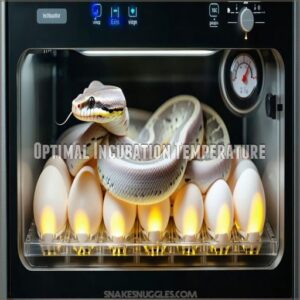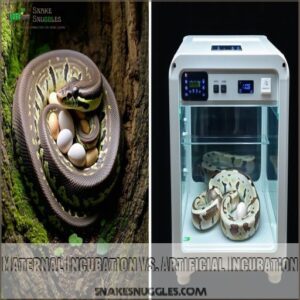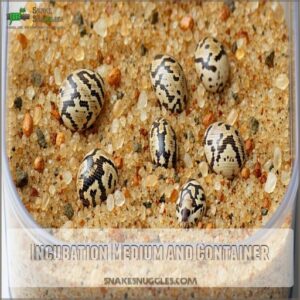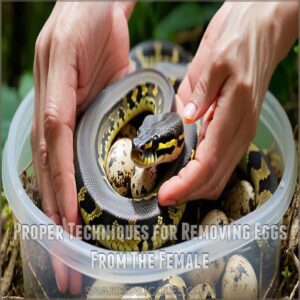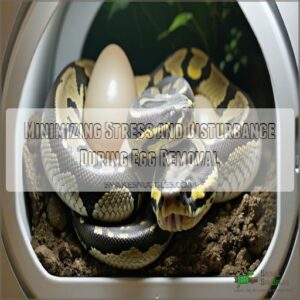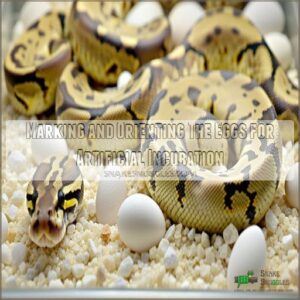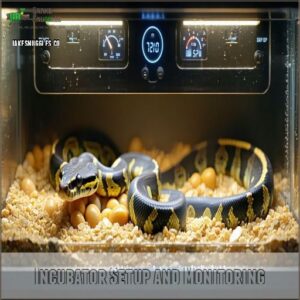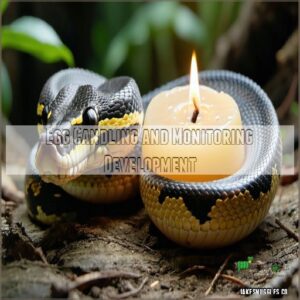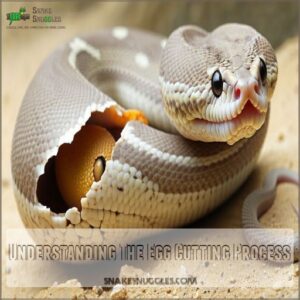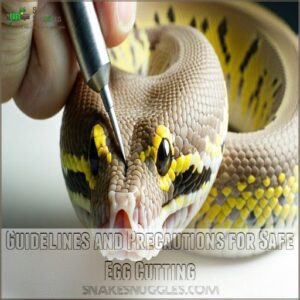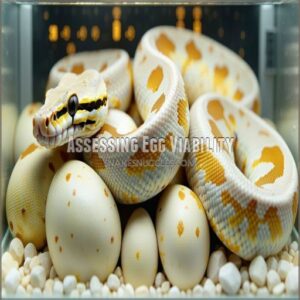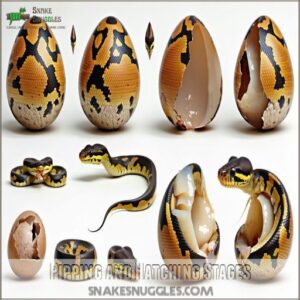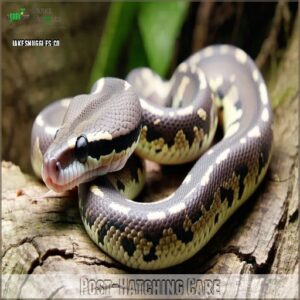This site is supported by our readers. We may earn a commission, at no cost to you, if you purchase through links.
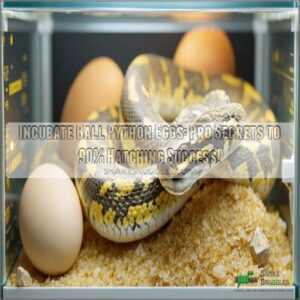 Want to incubate ball python eggs like a pro? You’ll need precision and patience!
Want to incubate ball python eggs like a pro? You’ll need precision and patience!
Set up your incubator between 88-90°F with 80-100% humidity using vermiculite as your substrate.
Gently remove eggs from the mother, marking each with an "X" to maintain orientation.
Monitor temperatures closely—even tiny fluctuations can doom developing embryos. Digital thermometers and hygrometers are your best friends here.
Candle eggs periodically to track development and catch any potential issues early.
After 55-60 days, you might need to help hatchlings emerge.
Remember, successful incubation is part science, part art—and all about creating the perfect snake nursery.
Table Of Contents
- Key Takeaways
- Optimal Incubation Temperature
- Maternal Incubation Vs. Artificial Incubation
- Incubation Medium and Container
- Egg Removal and Handling
- Incubator Setup and Monitoring
- Egg Candling and Monitoring Development
- Assisting Hatching: Egg Cutting
- Assessing Egg Viability
- Pipping and Hatching Stages
- Post-Hatching Care
- Frequently Asked Questions (FAQs)
- What temperature do you incubate ball python eggs at?
- Can I let my ball python incubate her own eggs?
- What can I use to incubate snake eggs?
- How to incubate ball python eggs without an incubator?
- How to incubate snake eggs without an incubator?
- Can you incubate ball python eggs at 85 degrees?
- How long do Ball Python Eggs incubate?
- Can a ball python incubate her own eggs?
- How do pythons incubate?
- How do ball pythons hatch?
- Conclusion
Key Takeaways
- You’ll nail ball python egg incubation by maintaining a precise temperature range of 88-90°F, which is critical for healthy embryo development and successful hatching.
- Your choice of incubation medium matters hugely—use vermiculite mixed in a 1:1 ratio with warm water, and always mark eggs with an "X" to preserve their original orientation during transfer.
- You’ll need to become a master of humidity control, keeping levels between 80-100% while vigilantly monitoring for any signs of mold or egg dehydration that could compromise your clutch.
- Candling is your secret weapon for tracking egg development, allowing you to identify viable eggs, detect potential issues early, and increase your chances of successful ball python reproduction.
Optimal Incubation Temperature
Regarding ball python egg incubation, temperature isn’t just a number—it’s the make-or-break factor that’ll determine your breeding success.
You’ll want to maintain a rock-solid 88-90°F range, because even a single degree can mean the difference between a thriving clutch and a disappointing outcome.
Ideal Temperature Range for Ball Python Egg Incubation
Temperature is the heartbeat of successful ball python egg incubation. Your mission? Nail that sweet spot between 88°F and 90°F (31°C to 32°C), where embryos transform from dormant potential to vibrant life.
To achieve this, it’s key to maintain a stable temperature, ideally between 88-92°F, with high humidity control using a commercial incubator or a DIY setup with precise temperature and humidity control.
- Imagine a cozy, consistent warmth nurturing delicate eggs
- Picture precise heat waves dancing around each precious shell
- Envision embryos thriving in their perfectly controlled microclimate
Importance of Maintaining Consistent Temperatures
Like a delicate dance of warmth, ball python egg incubation demands unwavering temperature consistency.
Thermal fluctuations are your worst enemy, threatening embryo development with each unexpected shift.
Your vigilance determines success: even minor temperature swings can derail the entire hatching process, transforming potential life into a heartbreaking loss.
Monitoring and Adjusting Incubator Settings
Keeping your ball python eggs thriving demands eagle-eyed monitoring and precision. After nailing that perfect temperature range, you’ll want to track every subtle shift with digital thermometers and hygrometers. Consistent surveillance prevents potential developmental disasters.
- Feel the excitement of watching life unfold
- Experience the thrill of potential success
- Embrace the delicate science of incubation
- Celebrate each careful adjustment
- Connect with your future hatchlings’ journey
Ventilation and sterilization are your secret weapons in this delicate dance of ball python egg incubation.
Maternal Incubation Vs. Artificial Incubation
You’ll need to choose between letting your ball python handle egg incubation naturally or taking control with an artificial setup.
Each method has unique benefits and challenges.
Understanding the pros and cons will help you boost your chances of successfully hatching healthy ball python eggs.
Advantages and Disadvantages of Each Method
After nailing the perfect temperature for your ball python eggs, you’ll want to choose between maternal and artificial incubation—each method’s got its own playbook.
Think of it like choosing between home cooking and a professional chef: both can deliver a delicious meal, but the techniques differ.
Regardless of the method, investing in the right equipment, such as a reliable ball python incubator, is essential for successful egg incubation.
| Method | Pros | Cons |
|---|---|---|
| Maternal | Natural process | Less controlled |
| Artificial | Precise monitoring | More equipment needed |
| Hybrid | Balanced approach | Requires expertise |
Your success hinges on understanding these approaches and matching them to your breeding goals and setup capabilities.
Factors to Consider When Choosing Maternal or Artificial Incubation
The complexity of ball python egg incubation demands a strategic approach. Choosing between maternal and artificial incubation isn’t just a coin flip—it’s a calculated decision balancing multiple critical factors.
| Factor | Maternal | Artificial |
|---|---|---|
| Control | Limited | High |
| Cost | Low | Moderate |
| Risk | Higher | Lower |
| Space | Mother’s Enclosure | Dedicated Incubator |
| Expertise | Natural | Technical |
Your experience level, the mother’s health, and precise environmental control will ultimately determine your most successful incubation strategy.
Preparing The Female for Maternal Incubation
A solid ball python maternal incubation journey starts with your female’s prime condition. Her health determines breeding success, so prepare her carefully. Make certain you can identify the signs of gravidity, such as noticeable abdominal swelling, to provide the best care during this critical period how to tell if your female ball python is gravid.
| Health Factor | Important Considerations |
|---|---|
| Weight | Above 1800g recommended |
| Diet | High-protein, nutrient-rich |
| Stress Levels | Minimize environmental disruptions |
| Medical Checks | Annual veterinary examination |
Your careful preparation sets the stage for successful ball python reproduction.
Incubation Medium and Container
When breeding ball pythons, you’ll need to choose the right incubation medium and container to give your eggs the best chance of survival.
Your goal is to create a stable, humid environment that mimics the natural conditions these reptiles need.
Using materials like vermiculite and an airtight container with precise temperature and moisture controls.
Suitable Substrates for Ball Python Egg Incubation
Almost every ball python breeder swears by vermiculite as the gold standard for egg incubation.
You’ll want to mix it precisely: one part vermiculite to one part warm water by weight, creating a substrate that holds moisture like a champ.
Perlite and coconut fiber work as solid alternatives.
Always sterilize your chosen medium to ward off mold, and position those precious eggs with surgical precision—no rotation allowed.
Your substrate choice can make or break hatching success.
Importance of Humidity Control in The Incubation Medium
Because humidity can make or break your ball python egg incubation success, you’ll want to nail those moisture levels like a pro.
To achieve ideal humidity levels, consider investing in a reptile humidity controller.
Aim for 80-100% humidity in your vermiculite substrate, adding warm water every six days to maintain that sweet spot.
Monitor closely—too dry, and embryos shrivel; too wet, and mold becomes your worst nightmare.
Selecting The Right Container for Egg Incubation
When diving into ball python egg incubation, your container choice can make or break breeding success.
- Spark confidence in your reptile breeding journey
- Protect delicate eggs from environmental fluctuations
- Provide precise climate control mechanisms
- Minimize contamination risks
- Create a sanctuary for embryo development
Airtight, sterilized containers between 12-18 inches work best for maintaining ideal incubation conditions.
Egg Removal and Handling
For ball python egg removal, you’ll need steady hands and a gentle touch to protect both mother and eggs.
Mark the top of each egg with a small "X" immediately after removal.
Maintaining their original orientation to preserve the delicate embryo’s development.
Proper Techniques for Removing Eggs From The Female
After carefully preparing your vermiculite nest, you’ll want to master the art of gentle egg removal.
Carefully lift the female python, supporting her body completely.
Gently slide your hands underneath her clutch, maintaining the eggs’ original position.
Your goal? Transfer the eggs without disrupting their delicate orientation, keeping each egg exactly as it was laid to maximize hatching potential.
Minimizing Stress and Disturbance During Egg Removal
Handling a ball python mother during egg removal demands a soft touch and keen awareness.
Create a quiet, stress-free environment that keeps her calm. Move with surgical precision—slow, deliberate actions prevent unnecessary agitation.
Your gentle approach during ball python egg incubation is like defusing a delicate time bomb.
Watch her body language, respect her space, and minimize disruptions.
The key to successful ball python egg hatching starts with a mother who feels secure and undisturbed.
Marking and Orienting The Eggs for Artificial Incubation
Don’t let your ball python egg incubation go sideways – literally!
Gently mark each egg’s top with a soft "X" using a graphite pencil, ensuring you preserve its original orientation.
Proper egg candling during artificial incubation can also help monitor embryo development.
This simple X marking technique prevents accidental rotation, which can spell disaster for embryo development during artificial incubation.
Keep it steady and precise.
Incubator Setup and Monitoring
Regarding ball python egg incubation, your setup is the make-or-break factor that’ll determine the success of your clutch.
You’ll want to invest in a reliable incubator, precise temperature and humidity controls, and a keen eye for monitoring—these are your secret weapons in hatching healthy ball python babies.
Essential Equipment for a Successful Incubator Setup
Designing your ball python egg incubator is like crafting a miniature life-support system.
You’ll need precision tools that transform a simple container into a hatching haven.
Here’s your essential equipment checklist:
- A rock-solid digital thermostat for temperature control
- Hygrometers that track humidity with laser precision
- Ventilated containers allowing ideal air circulation
Your incubator isn’t just equipment—it’s the critical nursery where delicate ball python eggs transform into vibrant new life. Invest wisely, and watch your breeding success soar.
Maintaining Optimal Temperature and Humidity Levels
Now that you’ve set up your incubator, mastering temperature and humidity is your ticket to hatching success.
Keep temperatures rock-steady between 88-90°F, with humidity hovering around 85-95%. A few degrees off can spell disaster for your precious ball python eggs.
Sanitize your setup religiously to ward off mold – it’s the silent egg killer.
Your goal? Create a microclimate that mimics nature’s perfect nursery. Whether you’re using an artificial or maternal setup, precision is your best friend in egg incubation.
Regularly Checking and Adjusting Incubator Parameters
After fine-tuning your incubator settings, vigilance becomes your best friend in ball python egg incubation. Monitoring is more than a chore—it’s your secret weapon for hatching success.
Investing in a reliable ball python incubator from chewy can help guarantee a stable environment for your eggs. Check temperature fluctuations twice daily Verify humidity levels consistently * Inspect for potential mold growth
Your incubator’s precision determines the survival of these delicate eggs. Small adjustments can make the difference between a thriving clutch and a disappointing outcome. Stay sharp, stay attentive.
Egg Candling and Monitoring Development
You’ll want to master egg candling to peek inside your ball python’s eggs and track their development like a pro breeder.
By holding each egg up to a bright light, you’ll reveal the fascinating world of growing embryos.
You’ll quickly spot any potential issues that could impact your hatching success.
Benefits of Egg Candling During Incubation
Watching your ball python eggs come to life through candling is like having a secret backstage pass to nature’s most incredible show.
By mastering this technique, you’ll gain the power of early detection and viability assessment during ball python egg incubation. You’ll spot potential issues before they become problems, turning you from a novice breeder into a snake-breeding wizard.
- Peek inside eggs without disturbing their delicate environment
- Catch signs of potential infertility or abnormal development
- Transform uncertainty into confident breeding success
Observing Embryo Development Through Candling
Your ball python egg’s story unfolds during candling, revealing nature’s intricate design.
Watch delicate veins branch like tiny rivers, tracing the embryo’s silent journey.
Each peek tells a tale of life stirring, transformation happening just beneath that fragile shell’s surface. candling
Identifying Potential Issues or Infertile Eggs
Peering into the egg’s translucent shell during candling reveals a world of embryonic mysteries.
Watch for telltale signs like emerging veins, subtle movement, and the expanding air cell—these whisper success.
Suspicious eggs stay eerily clear, lacking growth. Discoloration or funky odors? Red flags.
By mastering egg candling techniques, you’ll spot early development issues and ball python egg incubation problems before they become critical, boosting your clutch’s survival rate.
Assisting Hatching: Egg Cutting
When your ball python hatchlings struggle to break free, you’ll need to know the delicate art of egg cutting.
By understanding the precise techniques and potential risks, you can confidently assist your struggling reptilian offspring during their critical emergence stage.
egg cutting is essential when hatchlings struggle.
Understanding The Egg Cutting Process
After carefully tracking your ball python egg’s development through candling, you might encounter hatchlings struggling to break free.
Egg cutting becomes a precise skill requiring a sterilized, sharp scalpel or razor blade.
Gentle, strategic cuts can help stuck hatchlings emerge, but precision is key. Professional breeders use minimal intervention, making each careful slice count in supporting vulnerable snake babies.
Pros and Cons of Egg Cutting
Egg cutting is a delicate dance between intervention and potential disaster for ball python eggs.
Weighing hatching success rates against risks reveals a complex decision.
Some breeders swear by this technique, while others caution against disrupting nature’s process. Understanding the ethical considerations and alternative methods becomes essential for responsible reptile egg incubation.
Guidelines and Precautions for Safe Egg Cutting
When cutting ball python eggs, you’ll need surgical precision and a steady hand. Your sterile tools are your lifeline in this delicate procedure. Minimize risks by making a careful, small incision that avoids critical blood vessels.
- Master the cutting technique with patience and care
- Protect vulnerable hatchlings during the egg-cutting process
- Understand the nuanced art of reptile egg assistance
Post-cut monitoring is essential for ensuring your snake’s safe arrival into the world.
Assessing Egg Viability
You’ll need keen observation skills to determine whether your ball python eggs are viable and likely to hatch successfully.
By understanding the subtle signs of egg health through careful candling and monitoring, you can maximize your chances of nurturing those precious reptilian offspring.
Determining Egg Health and Fertility
Spotting healthy ball python eggs is like reading nature’s secret code.
Your keen eye and candling techniques reveal egg viability through telltale signs: pristine white shells, firm texture, and visible veins dancing beneath the surface.
These visual clues help you separate promising eggs from duds, boosting your ball python egg incubation success rate.
Recognizing Signs of Infertility or Incubation Problems
After tracking your ball python’s clutch, you’ll want sharp eyes for telltale trouble signs.
Healthy eggs boast a firm, whitish appearance and slightly sticky texture.
Watch for shell abnormalities like discoloration, suspicious mold patches, or dead embryos that signal incubation failure. During candling, lifeless eggs reveal no growth or movement—a red flag for viability.
Additionally, check for insufficient humidity that can cause egg dehydration and deflation.
Trust your instincts: an unusual odor or sluggish development might mean it’s time to reassess your ball python egg incubation strategy.
Appropriate Actions for Non-viable or Problematic Eggs
Discovered a dud in your ball python egg clutch? Act fast to protect your future hatchlings.
Here’s your game plan for handling problematic eggs:
- Remove infected eggs immediately to prevent contamination spread
- Double-bag and safely discard non-viable eggs
- Sanitize your incubation setup thoroughly
- Investigate and correct potential temperature or humidity issues
Your quick response can save the entire clutch’s success.
Pipping and Hatching Stages
As you approach the final stages of ball python egg incubation, you’ll witness one of nature’s most fascinating transformations.
You’ll want to understand the pipping and hatching process to guarantee your hatchlings emerge safely and successfully.
Explanation of The Pipping and Hatching Process
When ball python eggs start pipping, you’re witnessing nature’s most delicate dance.
The hatchling uses its specialized egg tooth to create a precise crack in the shell, gradually widening the opening.
This process typically takes 24-48 hours, during which the snake methodically breaks through its protective membrane, preparing for its first gasp of air outside the egg.
Observing and Assisting The Hatchling Ball Pythons
As your ball python hatchlings break free from their eggs, get ready for an exciting journey! Observing these tiny reptiles requires patience and a keen eye.
Here’s your hatchling survival guide:
- Move slowly and minimize handling
- Check for complete egg emergence
- Verify breathing and movement
- Monitor body condition and skin integrity
Your newborn ball python hatchlings are delicate masterpieces, ready to explore their world with cautious curiosity.
Ensuring a Successful and Safe Hatching Experience
If you want ball python hatchlings to thrive, treating egg viability like a precision science is essential.
Your incubator becomes a lifeline for these delicate eggs.
Controlling humidity between 85-95% and maintaining rock-solid temperature gradients can mean the difference between successful ball python egg incubation and heartbreak.
Every tiny detail matters – from minimizing egg disturbance to creating a stable, controlled environment that nurtures life.
Post-Hatching Care
After your ball python hatchlings emerge from their eggs, you’ll need to create a carefully controlled environment that mimics their natural habitat to support their survival and health.
You’ll focus on maintaining precise temperature and humidity levels.
Minimizing handling and providing appropriately sized prey to support these delicate newborn snakes during their critical first weeks of life.
Temperature and Humidity Requirements for Newborn Ball Pythons
Every newborn ball python needs a goldilocks zone of temperature and humidity to thrive.
Keep their habitat rock-solid at 88-90°F with a cooler side around 80°F.
Nail the humidity between 50-60% using precise monitoring equipment.
Your careful temperature stability and ventilation setup isn’t just good practice—it’s your hatchling’s lifeline to robust health and ideal ball python egg incubation success.
Feeding and Handling Recommendations for Hatchlings
Tiny pythons demand gentle finesse in their early days.
Your first feed sets the stage for lifelong health – match prey size to your hatchling’s delicate girth.
Handle with soft, deliberate movements, keeping interactions brief and purposeful.
Create a sanctuary that mimics their natural habitat: warm, secure hiding spots that whisper safety. Monitor growth closely, ensuring each interaction builds trust and confidence in their new world. Lifelong health and gentle finesse are key.
Addressing Common Issues and Challenges During The Early Stages
After successfully feeding your new hatchlings, watch for red flags like early mortality or stuck babies struggling to emerge.
Fungal growth can quickly derail your ball python egg incubation success.
Monitor closely for dehydration issues and potential incubation failures.
Proper Ball Python Hatchling Humidity Control is also vital, as it helps with smooth shedding and overall health.
Quick interventions—gentle humidity adjustments, careful handling, and keen observation—can turn potential disasters into thriving little serpents.
Frequently Asked Questions (FAQs)
What temperature do you incubate ball python eggs at?
Born from delicate precision, ball python eggs thrive at 88-90°F.
You’ll want to maintain this steady temperature like a watchful guardian, ensuring your serpentine offspring develop safely in their warm, nurturing environment.
Can I let my ball python incubate her own eggs?
You can let your ball python incubate her eggs, but it’s risky.
Maternal incubation works in the wild, yet captive environments can compromise egg health.
Professional incubators offer more consistent temperature and humidity control for better hatchling survival.
What can I use to incubate snake eggs?
Start snake egg incubation with a commercial reptile incubator, digital thermometer, and vermiculite.
Choose precision over guesswork.
Your reliable setup guarantees temperature stability, humidity control, and creates a cozy nursery for your slithery friends’ future hatchlings.
How to incubate ball python eggs without an incubator?
Want to hatch ball python eggs without an incubator?
Create a DIY setup using a sealed container, heating pad, and precise thermometer.
Maintain steady 88-90°F temps with vermiculite substrate and careful humidity monitoring for successful egg development.
DIY ball python egg hatching requires precise temperature and humidity control.
How to incubate snake eggs without an incubator?
Improvise a warm, stable space like an insulated cooler or old refrigerator.
Use heat sources cautiously, maintaining steady temperatures near 88-90°F.
Place eggs in vermiculite, monitor humidity carefully, and turn gently every few days to guarantee successful incubation. This will ensure steady temperatures.
Can you incubate ball python eggs at 85 degrees?
You’ll struggle to successfully incubate ball python eggs at 85 degrees. This temperature is too low, risking embryo development problems.
Aim for the best 88-92°F range to guarantee healthy egg and hatchling survival.
How long do Ball Python Eggs incubate?
Ball Python eggs typically incubate for 55-60 days at 88-90°F.
Your patience pays off as these delicate orbs transform into vibrant hatchlings.
Consistent temperature and humidity are key to successful egg development and healthy snake birth. Egg incubation requires careful attention.
Can a ball python incubate her own eggs?
Maternal incubation’s possible, but risky.
Your female python might protect her eggs, yet temperature and humidity control remain challenging.
Professional incubators offer more consistent conditions for successful hatching and snake health.
How do pythons incubate?
Like a cozy nursery for nature’s serpentine gems, pythons incubate eggs.
They maintain a steady 88-90°F environment for successful embryo development.
Pythons use either maternal body heat or specialized incubators for precise temperature and humidity control.
How do ball pythons hatch?
You’ll watch your ball python hatchlings break through their eggs using an egg tooth, typically taking 24-48 hours.
They’ll emerge slowly, wet and curled, gradually unfurling as they dry.
ready to start their exciting new life. ball python hatchlings
Conclusion
When science meets passion, incubating ball python eggs transforms from a challenge to an art form.
You’ve learned the intricate dance of temperature, humidity, and careful monitoring.
Mastering the process of incubate ball python eggs isn’t just about technology—it’s about creating life.
Whether you’re a seasoned breeder or a curious beginner, patience and precision are your greatest tools.
Success awaits those who commit to understanding these delicate reptilian miracles.

